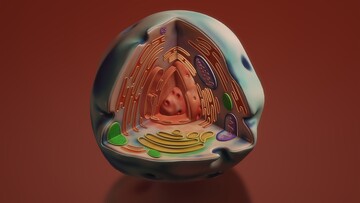What are the functions of the different parts of a cell?

Cell structure and organization in layers.

Cell structure and organization in layers.
The nucleus is the control center of the cell. It contains the cell's DNA, which is like a set of instructions for how the cell works. The nucleus also makes ribosomes, which are tiny factories that make proteins.
The mitochondria are the power plants of the cell. They produce energy for the cell to use. Mitochondria are often called the "batteries" of the cell.
The cytoplasm is the jelly-like substance that fills the cell. It contains all the organelles, which are the tiny structures that do the work of the cell. The cytoplasm is also where the cell's waste products are produced.
The cell membrane is the outer layer of the cell. It protects the cell and controls what goes in and out of the cell. The cell membrane is like a gatekeeper that lets only certain things into the cell.
Here are some concrete examples of how the different parts of a cell work:
- The nucleus tells the ribosomes to make proteins. Proteins are used to build new cells, repair old cells, and fight off infection.
- The mitochondria produce energy for the cell to use. This energy is used to power all the cell's activities, such as moving and duplicating.
- The cytoplasm is where all the organelles are found. The organelles do all the work of the cell, such as making proteins, producing energy, and getting rid of waste.
- The cell membrane protects the cell and controls what goes in and out of the cell. This is important because the cell needs to keep its environment stable in order to function properly.
The different parts of a cell work together to keep the cell alive and functioning. The nucleus, mitochondria, cytoplasm, and cell membrane are all important parts of the cell, and each part has its own specific function. Without these parts, the cell would not be able to survive.
How do cells repair themselves?
Cells repair themselves by using the instructions from the DNA inside the nucleus. Just like how we can fix a broken toy by following the instructions from a manual, cells can also fix any damages they have. They send out special molecules called enzymes to help with the repairing process. For example, if a cell gets a cut or a scratch, the enzymes will come and fix it, just like a handyman fixing a broken window.
How does the cell membrane protect the cell?
The cell membrane is like a bodyguard for the cell. It protects the cell from harmful things that want to come in and keeps the important things inside. It's like a gatekeeper that only allows good and helpful things to come in and out. For example, imagine the cell membrane is like a fence around a house. It keeps out intruders and only lets in the visitors that the family wants.
What is the function of the cytoplasm in a cell?
The cytoplasm is like a big jelly that fills the cell and helps all the tiny structures, called organelles, in the cell do their jobs. It's like the stage where all the actors perform their roles in a play. The organelles make all the important things the cell needs, like proteins. They also get rid of waste, just like we throw our trash in a trash can. The cytoplasm is like the backstage area where everything happens and where the cell stays busy and alive.

Cell structure and organization in layers.